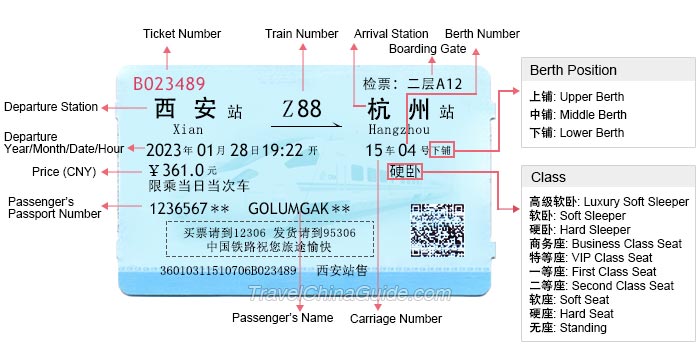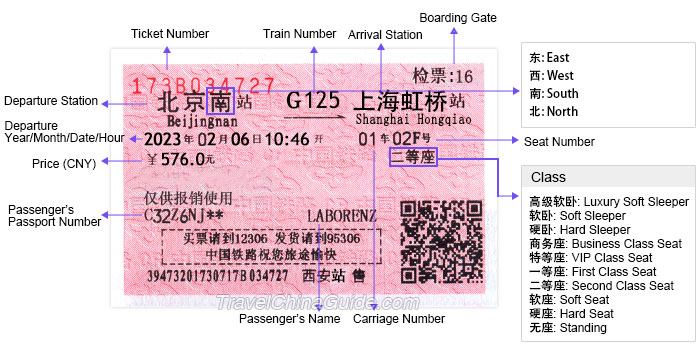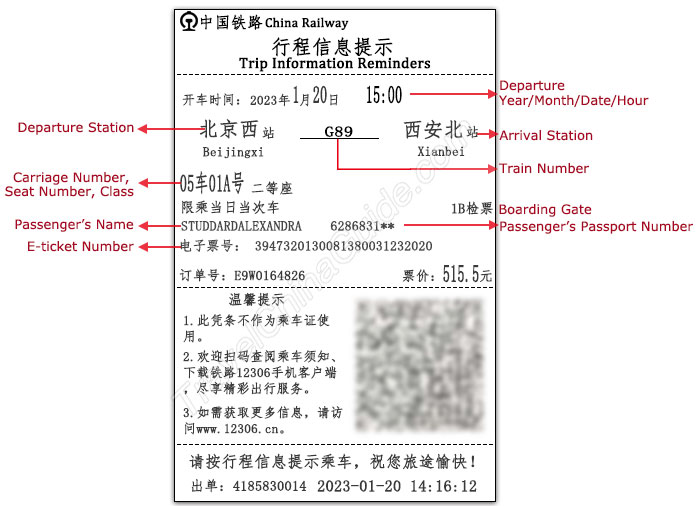How to Read China Train Tickets
In addition to the above two versions of "train tickets in China", "Trip Information Reminders" are also given to remind passengers of related train information.
Please note that all three of them cannot be used to take the train. Most China trains now allow boarding only after checking the ID certificate used for booking the e-ticket.
Ticket Number
Boarding Gate
 |
 |
Departure and Arrival Stations
In China, a railway station is usually named after the city, such as ‘西安(Xi'an)站(railway station)’. When the city has more than one station, any station built later is named as ‘city name+location of the station in that city’, like ‘北京(Beijing)南(south)站(railway station)’. The locations used in station names are usually ‘东(east)’, ‘西(west)’, ‘南(south)’, and ‘北(north)’, while a few are local well-known places like Shanghai Hongqiao and Luoyang Lonegmen.
Train Number
Departure Date and Time
Carriage Number and Seat/Berth Number
Inside normal trains, seats are numbered with digits while in high speed ones, seats are numbered with digits plus an English letter.
Berths inside the carriages are identified by ‘digits+location’, like 04号上铺, meaning no.04 upper berth. Usually, there are上铺(upper berth), 中铺(middle berth), and下铺(lower berth) inside sleeper carriages.
Class
| 高级软卧: Deluxe Soft Sleeper | 软卧: Soft Sleeper |
| 硬卧: Hard Sleeper | 商务座: Business Class Seat |
| 特等座: VIP Class Seat | 一等座: First Class Seat |
| 二等座: Second Class Seat | 软座: Soft Seat |
| 硬座: Hard Seat | 无座: Standing (no berth or seat) |
Price
Below it, the Chinese sentence says: Permission only for the specific train of the printed date and time.
Passenger’s Certificate Number and Name
Advertisement
Printing City
To its left, is a code made up of digits and English letters. It is used to verify the authenticity of the ticket, as does the two-dimensional code in the right bottom corner.
How to identify the authenticity of a "ticket"?
1. Watermark: The watermark must be printed clearly.
2. Feel: An authentic one will be smooth to the touch. Some fake ones may feel rough, and their printing may rub off or not be printed neatly.
3. Flexibility: Roll the ticket up and twist it. An authentic one will resume its original shape.
4. Comparison: Compare the ticket with an authentic one you already have.
5. Code: Every ticket has a set of codes at the top left (e.g. B023489 in the blue sample). You could find a corresponding set of codes at the bottom left (e.g. 36010311510706B023489).
6. Anti-fake Code: On the lower right, there is an anti-fake two-dimensional code which records train no. and passenger’s information.
How to Read China Train "Trip Information Reminders"
Also from top to bottom and left to right, it shows the departure time of the train, departure station, train number, arrival station, carriage number, seat/berth number, seat/berth class, and passenger’s personal information, etc. What are different from the above red and blue “tickets” are that the boarding gate and ticket price are showed in the right lower part.
 |
